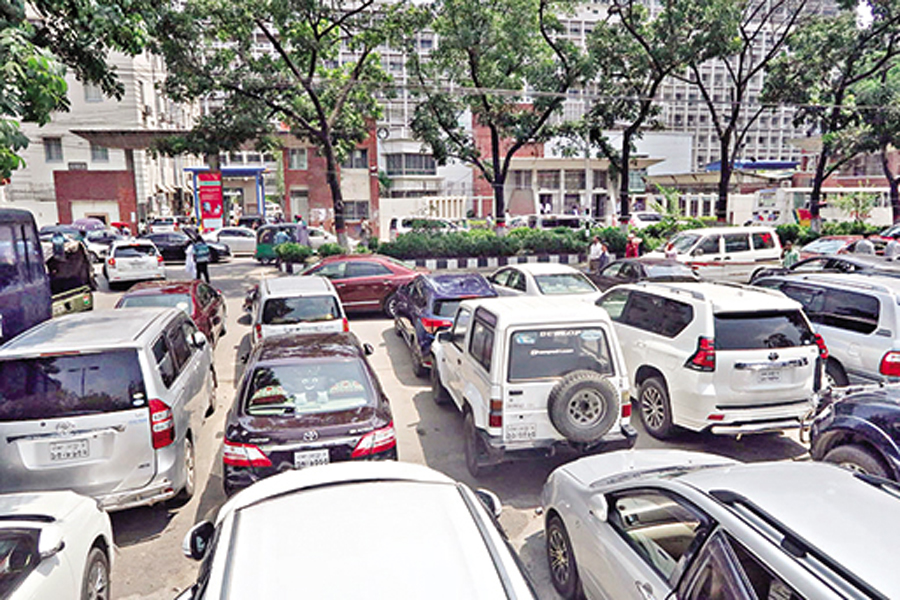
Published :
Updated :

The Dhaka Transport Coordination Authority (DTCA) made a significant decision years ago, approving a proposal to establish 64 parking lots within the capital. This decision ignited hope among city dwellers and those concerned about addressing the persistent issue of vehicular gridlock. However, despite the passage of considerable time, there has been no visible progress on this front-- the reasons behind the delay known only to the authorities.
The decision to develop adequate vehicle parking facilities in Dhaka stemmed from the shortcomings of the transport law introduced previously. One of the primary obstacles to implementing this law was the lack of legal parking facilities, not only in the capital but also in major cities across the country. Ironically, the transport law, which aimed to crack down on illegal parking, failed to recognise the crucial need for legal parking facilities as a prerequisite for its effectiveness. Consequently, the absence of such facilities made it challenging, if not impossible, to enforce the law. As a remedy to the issue of unauthorised parking, the establishment of legal parking facilities was considered essential. Regrettably, like many other government decisions, this initiative seems to have been sidelined.
The proposal to set up 64 parking spots and bus bays in the city was accompanied with additional decisions, such as freeing footpaths from hawkers and relocating inter-district bus terminals away from the city centre. While there have been some efforts to relocate bus terminals, silence over the establishment of parking facilities within the city persists. Moreover, there was a decision that the Rajdhani Unnayan Kartipakkhya (RAJUK) would need clearance from the DTCA for multistoried parking structures before approving their designs. It is not known if anything has been done to implement that decision.
With no progress evident, the question arises: what impedes the implementation of this plan? The logical starting point should have been to identify suitable sites through consultation with key stakeholders and then develop user-friendly and purposeful designs. The authorities have remained silent on the matter, leaving doubts about the true reasons behind the situation.
The capital's vehicular movement and the associated problems are the most spoken issues. Establishing adequate parking facilities is not merely a matter of convenience but a crucial component of urban planning and sustainable development. Properly managed parking infrastructure not only reduces traffic congestion by minimising illegal roadside parking but also encourages the use of public transports and non-motorised modes of travel. Moreover, it contributes to efficient utilisation of urban space, enhances pedestrian safety, and improves the overall liveability of the city.
The authorities' isolated and disconcerted actions have proved ineffective. Without purpose-driven initiatives such as multilayered parking spaces, traffic management will continue to be an insurmountable challenge. It is commonly believed that disciplining city traffic will foster a sense of order in various other aspects of urban life. The pertinent question now is whether the authorities concerned will revisit the decision and take concrete steps towards its implementation.
Rapid growth of the city's population, coupled with an increasing number of vehicles on the roads, has exacerbated congestion and pollution, leading to significant economic and social costs. Studies have shown that traffic congestion in Dhaka results in substantial productivity losses, environmental degradation, and adverse health effects for residents.
However, it is well assumed that the challenges before implementation of such initiatives in Dhaka are manifold. They range from bureaucratic red tape and funding constraints to competing priorities and political considerations. The lack of coordination among relevant government agencies and stakeholders further complicates matters, leading to delays and inefficiencies in project implementation.
Addressing the issue of parking in Dhaka requires a holistic approach that takes into account land use planning, zoning regulations, and transportation management strategies. According to transport experts, encouraging mixed-use development, promoting transit-oriented development, and implementing innovative parking pricing mechanisms can help optimise the use of limited urban space while minimising the negative impacts of car-centric urban sprawl.
Moreover, public awareness and community engagement are essential for garnering support for parking infrastructure projects and fostering a culture of responsible urban mobility. Educating residents about the benefits of using alternative modes of transportation, such as walking, cycling, and carpooling, can help reduce reliance on private vehicles and alleviate pressure on parking facilities.
The stalled initiative for establishment of parking facilities reflects broader systemic challenges in urban governance and transportation planning. Addressing these challenges requires concerted efforts from government agencies, urban planners, civil society organisations, and the general public. Only through concerted efforts and decisive action can Dhaka hope to achieve sustainable urban mobility and improve the quality of life for its residents.


 For all latest news, follow The Financial Express Google News channel.
For all latest news, follow The Financial Express Google News channel.